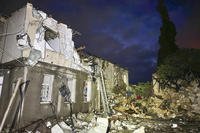WARMINSTER, Pa. (AP) — William Dobbs didn’t miss the boat.
But the ship the young soldier was assigned to take from North Africa to the China-Burma-India theatre during World War II, His Majesty’s Transport Rajula, had to turn back to port. It couldn’t keep up with its sister ship, HMT Rohna, in a convoy crossing the Mediterranean.
Too many barnacles attached to its hull and engine trouble slowing the ship down might have saved Dobbs’ life.
As he looks back on his war experiences, Dobbs — a North Jersey native now living in Warminster — took time to remember the 124 members of his 31st Signal and Construction Battalion who were among 1,015 American soldiers killed when a Nazi-guided missile sunk the Rohna on Nov. 26, 1943.
The ship’s sinking resulted in the largest number of American soldiers killed at sea during World War II and would become known as the first casualty of a radio-guided missile ever launched against the U.S. — once declassified decades later.
Rohna’s fate shrouded in secrecy
The remote-controlled Henschel HS 293 bomb, released by a German airplane, was the first of its kind. The Allied command didn’t want word of the terrifying device to get out, less it demoralize American and British forces fighting the Nazis, so they classified the attack and made the survivors keep the secret, under threat of court martial.
The history of the Rhona wasn’t declassified until the 1990s and wasn’t really known by the American public until Charles Osgood reported it on his radio show on Veterans Day, 1993.
The Rohna, a British cargo ship that was to transport American soldiers to Southeast Asia, was bombed by the Nazis with a guided missile on Nov. 26, 1943. More than 1,000 soldiers were killed or drowned in the attack which was kept classified for 50 years, historians say.
But, some were determined not to let it fade into history.
Caitlin McHugh, of Philadelphia, Dobbs’ granddaughter, researched the Rohna’s history for a paper she wrote as a student at Cornell University, “Unraveling the Secret Behind the HMT Rohna.” It was published by Ezra’s Archives, a Cornell Historical Society publication, in spring 2011.
For 50 years from 1943 to 1993, families never learned the fate of their soldiers who went down with the ship and survivors needing medical and other veteran benefits had long battles back home trying to prove that their war injuries were legitimate while keeping the secret about the vessel’s sinking, McHugh noted in her report.
Now the Rohna Survivors Memorial Association is trying to find survivors and make contact with the families of those killed. Some 104 Pennsylvanians died, another 79 from New Jersey and three from Delaware, according to records. New York saw 133 causalities.
“Most of the bodies of the soldiers were never recovered; there were no funeral services or burials — the boys just never came home,” said Jack Ballo, who is producing a documentary, “Rohna: Classified,” about the ship’s sinking. The South River, New Jersey, filmmaker got started researching the ship after finding letters in his attic that were sent home by Joseph Pisinski, his wife’s great-uncle who was one of the soldiers killed.
The film’s outreach project is also working to identify families of the casualties.
According to the researchers, 35 Nazi planes targeted the 24 ships in the convoy heading to India that day, but the remote-controlled bombing of the Rohna was the major tragedy. Air power to protect the ships was missing due to preparations for the D-Day invasion.
‘Worst 35 days of my life on that ship’
Dobbs said it was his good fortune during the war to be sent back to port twice.
The Liberty Ship Patrick Henry that was supposed to transport him and other troops to Africa from Newport News, Virginia, in October 1943, was late getting started across the dangerous, U-boat infested Atlantic Ocean, so it had to head back to port to wait for a new convoy to form.
By the time Dobbs got to Africa 11 days later, the manifest for the Rohna going to India was set. He was assigned on the Rajula, its sister ship.
Both were operated by the British India Steam Navigation Co. but had been converted from cargo to troop ships during World War II. Due to is engine difficulties, the Rajula had to go back to port on that late November day when the convoy it should have been in was targeted by the Nazis.
“I got sent back twice by God,” Dobbs said.
In her essay, McHugh, who is now an attorney, noted: “The Rohna was originally a civilian ship designed to hold 100 people comfortably. On the fateful transport mission in 1943 from Oran, Algeria, to India, the HMT Rohna was carrying 2,193 military personnel and 195 crew members, roughly twenty times its capacity. The result of this massive overloading was that the men were crowded below deck in appalling conditions.”
Dobbs remembers that both the Rohna and the Rajula were “overly crowded ... It was the worst time,’” he said. “We weren’t allowed to come upstairs for 30 days.
“I spent the worst 35 days of my life on that ship; we were practically starved, went on a hunger strike, not enough latrines or washing facilities, sleeping quarters, slept on tables, on floors, on barrack bags and any other place a body could squeeze.”
He thought similar conditions existed on the Rohna and it was vulnerable even before leaving the harbor.
According to the Rohna Memorial Association website, created in 1998, the events, which occurred after the Rohna was struck by the guided missile “were so shameful that the secrecy continued for decades,” McHugh reported.
‘I knew we were missing men’
Dobbs said that when he arrived in Bombay, India, after the Rajula safely crossed the Mediterranean and the Suez Canal with another convoy, the men already there said, “Where did you guys come from? You’re supposed to be dead.”
Dobbs didn’t learn that the Rohna was downed by a missile until the report on its sinking was declassified but he said, ”I knew we were missing men.”
He learned from the tragedy that training is so important.
The men aboard both the Rohna and Rajula were given a life preserving belt that was inflated by pressing on carbon dioxide cartridges, he said, but “they were never given instruction how to use it” so many on the doomed ship jumped overboard with them tied as a belt at their waist.
They should have moved them up under their arms to keep their heads afloat, Dobbs said. Instead, when the belt inflated, it brought their midsection and rear to the surface, not allowing them to right their head above the choppy water.
“On the Rohna, they lost hundreds of people who jumped in the water and drowned ... Once it inflates, it tightens around your waist. They couldn’t get their heads up... Hundreds died because of it,” Dobbs said.
He said that Gen. Dwight Eisenhower required training in the use of the lifesaver belts before the D-Day invasion.
Survivors reported that the lifeboats aboard the Rohna were old, were almost glued to the ships with paint and some of their chains were rusted in place.
As men tried to escape the crippled ship, some of the lifeboats that were able to be freed tumbled over, killing many in the boats and those who may have jumped into the water below them.
A nearby ship, the USS Pioneer picked up many of the survivors, some of whom had been in the cold, November waters for hours.
Surviving the war
When Dobbs got to India, he quickly got to work in the headquarters office for his battalion.
“When I was in high school I could type 100 words a minute. I was the best typist in the high school,” he said.
He also scored very highly in an aptitude test even though he hadn’t studied academic courses in school, so the Army asked him what he would like to do. He said work in personnel. He was assigned to a commanding officer, who was an older attorney in civilian life. Promotions soon followed.
When his boss’ tour of duty was up, Dobbs took charge of the department, being promoted to staff sergeant. “I came in sitting on a box. I went out running personnel,” Dobbs said with a smile. His pay was $96 a month.
He said the battalion was responsible for setting up signal wires over hundreds of miles from Assam Valley in India, going through the hot, mosquito-infested jungles in Burma to Kunming, China.
After the war, Dobbs went back to school to take English and algebra classes before enrolling in Rutgers University where he graduated with a degree in accounting.
But then, as he sat crunching numbers on a calculator, he realized accounting wasn’t for him.
He and his brother Louis took over their dad’s auto body shop in 1954, moved it to Springfield in North Jersey, and started Dobbs’ Auto Body, a successful business that could service 23 cars at a time and employed 20 people.
“It’s still there. I retired in May 1999,” he said. “It’s probably one of the oldest businesses in Springfield.”
As he spoke, Minnie, his wife of almost 70 years nodded in agreement. The couple have three children and four grandchildren.
Still spry at age 97, Dobbs hasn’t kept many mementos of his war years, but he did keep his Army uniform jacket. He didn’t wear the decorated wool jacket much in the hot jungles of Southeast Asia, but it still fits him, though the buttons won’t close.
“Believe it or not, I was 147 pounds when I got out of the Army. If I get on the scale now, I’m 147,” he said.
Honoring the Rohna and its sacrifice
World War II veteran William Dobbs, of Warminster, reminiscences about his two years in the service.
Dobbs said he’s proud that his granddaughter saw the loss of the lives on the ship as needing recognition and that her efforts and those of other historians and Ballo with his documentary film will help share its history with a wider audience.
The fate of the Rohna and its soldiers was finally recognized by Congress in October 2000 when the late Congressman Jack Metcalf of Washington spearheaded a campaign to have a tribute to the soldiers and crew of the Rohna read in Congress and placed in the Congressional Record.
McHugh’s parents, Diane Dobbs and her husband, Dr. Joseph McHugh, of Newtown Township, are proud that their daughter took such an interest in her grandfather’s story which she first learned about when she interviewed him for a seventh-grade project.
“It stuck with her and she ran with it,” her mom said. Now experts are calling her for more information.
In her paper, McHugh wrote that there were three reasons why the Rohna sinking was secret for so long: the immediate needs to avoid demoralizing troops during the war, followed by the American and British governments not wanting to cast blame for the condition of the ships or the lack of proper training in the rescue operation, as well as the communication issues that arise when two governments both had classified documents on the tragedy to declassify.
Without this veil of secrecy, McHugh said, “maybe then the HMT Rohna could have taken its due place next to the celebrated and observed disasters such as the RMS Lusitania in the Atlantic and the USS Arizona at Pearl Harbor and earned its rightful place in the hearts and minds of the American people.”











